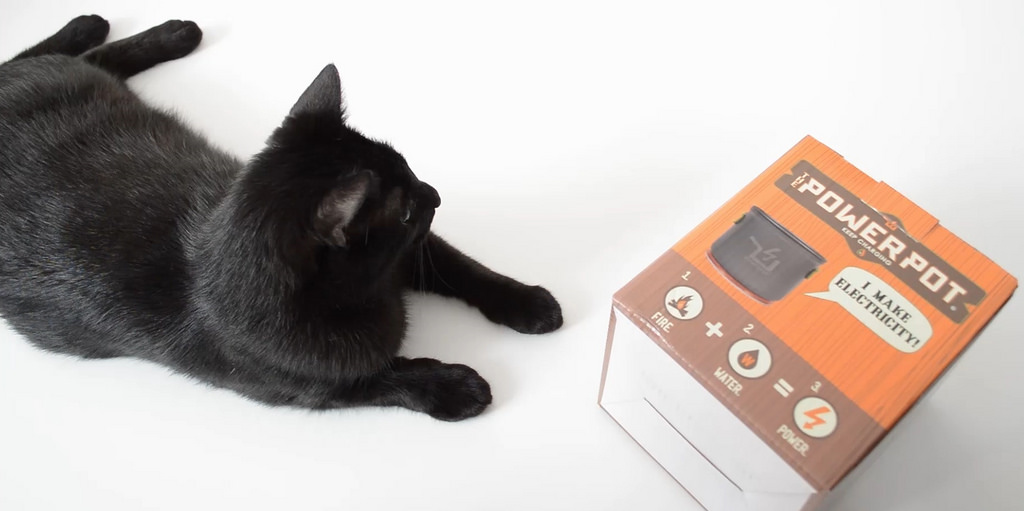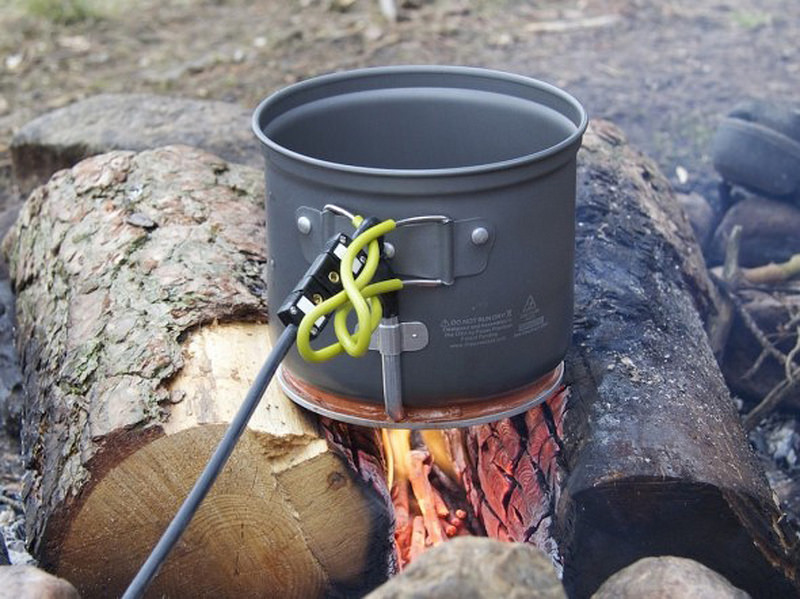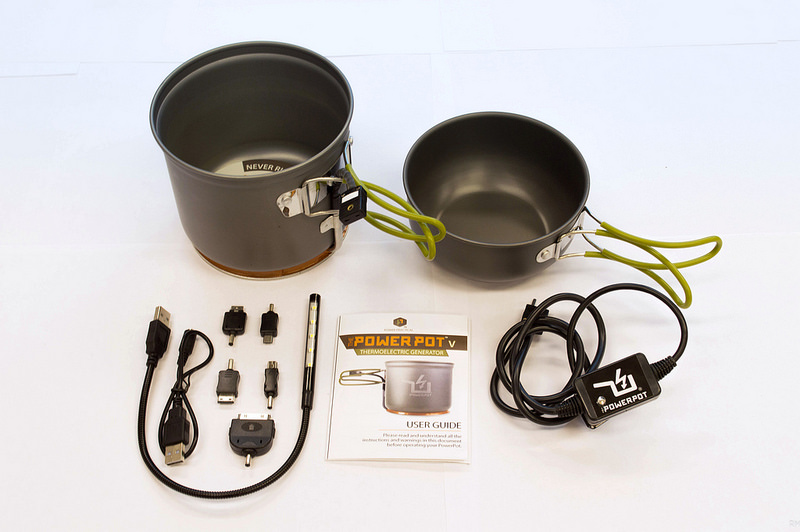PowerPot - a pot that can charge your smartphone
Kickstarter PowerPot came to me - a thermoelectric generator, which is part-time anodized aluminum pot! And in this post I will not only tell you about it, but also answer the question: “What is better to charge a smartphone, dumplings or pasta?”
Let me remind you that earlier this magic pot collected on Kickstarter $ 126,000 in its first version and almost $ 74,000 in the upgraded second one .

')
For those who do not like to read, I tried to prepare a video review of the pot, which begins with unpacking and ends with the preparation of dumplings.
I got the first version of this magic pot. And first I will talk a little about its characteristics.
There are three types of bowlers that vary in volume: 1.4 liters, 1.9 liters, 3.8 liters. They also generate from 5 to 15 watts depending on the volume. Electricity is produced by the Peltier element, which generates a current from the temperature difference between the contents of the pot and the heated bottom.
The capacity of my small saucepan is 1.4 liters. This is quite enough to brew tea in field conditions or cook a few portions of cereal for breakfast.


The box contains the following components:
The instruction in Russian is attached, as I got the bowler from the Russian online store.

And now for the fun part. How well does the pot charge the smartphone?
I have not yet opened the tourist season, so I used the pot only at home. He warmed it on the electric and gas stove. In optimal mode, we get 5V and 1A.
For starters, I tried to charge the phone.
iPhone 5c for cooked dumplings gets 13% and it takes 33 minutes . Given the battery capacity of 1510 mAh, we get 6 mAh per minute .
Then I charged the iPad Mini . It took me 34 minutes to cook pasta and this gave only 4% of the battery with a capacity of 4400 mAh. Charging speed was only 5.2 mAh per minute .
It is worth noting that the dumplings are better suited for charging devices. And that's why:
The algorithm of the Peltier element is such that we get the maximum current at the maximum temperature difference. That is, for charging, it is advantageous not to boil water, but to bring it to a boil and change it to a cold one. Dumplings when thrown into boiling water, it is cooled very much, unlike pasta. True, frozen semi-finished products are not exactly field food.
1. When charging the iPhone 5C, the error periodically pops up that this accessory is not supported. You have to reconnect the phone and charging is normal. For half an hour I reconnected several times. There were no such problems with the tablet.

2. The manual says that for careful work with the Peltier element - it is impossible to pour out all the water from the pot, but you need to leave a third of the pot so that the element is gradually cooled. I had to dig out a special scoop, as before I always poured water after cooking. Now I catch =)
Of course, bothering and fully charging the smartphone using a kettle is difficult. But on the trip three times to get 15% of the phone's charge is pleasant. After all, a smartphone is no longer a phone, but a camera, navigator, player, and God knows what else.
In the next campaign, I will definitely test the kettle in combat conditions. At first glance, it seems to me that I will not spare him a place in a backpack.
Let me remind you that earlier this magic pot collected on Kickstarter $ 126,000 in its first version and almost $ 74,000 in the upgraded second one .

')
For those who do not like to read, I tried to prepare a video review of the pot, which begins with unpacking and ends with the preparation of dumplings.
I got the first version of this magic pot. And first I will talk a little about its characteristics.
There are three types of bowlers that vary in volume: 1.4 liters, 1.9 liters, 3.8 liters. They also generate from 5 to 15 watts depending on the volume. Electricity is produced by the Peltier element, which generates a current from the temperature difference between the contents of the pot and the heated bottom.
Read more about the Peltier principle
A single element of a thermoelectric module (TEM) is a thermocouple, consisting of two dissimilar elements with p- and n-type conductivity. Elements are interconnected by means of a switching plate made of copper. As the material of the elements, semiconductors based on bismuth, tellurium, antimony and selenium are traditionally used.

Thermoelectric module (Peltier element) is a set of thermocouples, electrically connected, as a rule, in series. In a standard thermoelectric module, thermocouples are placed between two flat ceramic plates based on aluminum oxide or nitride. The number of thermocouples can vary widely - from units to hundreds of pairs, which allows you to create TEM of almost any cooling power - from tenths to hundreds of watts. When a direct electric current passes through the thermoelectric module, a temperature differential forms between its sides - one side (cold) cools, and the other (hot) heats up. If on the hot side of TEM to ensure effective heat removal, for example, using a radiator, then on the cold side you can get the temperature, which will be tens of degrees lower than the ambient temperature. The degree of cooling will be proportional to the magnitude of the current. When changing the polarity of the current hot and cold sides are swapped.

Thermoelectric module (Peltier element) is a set of thermocouples, electrically connected, as a rule, in series. In a standard thermoelectric module, thermocouples are placed between two flat ceramic plates based on aluminum oxide or nitride. The number of thermocouples can vary widely - from units to hundreds of pairs, which allows you to create TEM of almost any cooling power - from tenths to hundreds of watts. When a direct electric current passes through the thermoelectric module, a temperature differential forms between its sides - one side (cold) cools, and the other (hot) heats up. If on the hot side of TEM to ensure effective heat removal, for example, using a radiator, then on the cold side you can get the temperature, which will be tens of degrees lower than the ambient temperature. The degree of cooling will be proportional to the magnitude of the current. When changing the polarity of the current hot and cold sides are swapped.
The capacity of my small saucepan is 1.4 liters. This is quite enough to brew tea in field conditions or cook a few portions of cereal for breakfast.

Now it's time to look at the Power Pot equipment.

The box contains the following components:
- The pot itself
- A smaller saucepan that can be used as a bowl and as a lid for the main pot
- A cover in which you can carry the kettle on the hike
- Cable that connects to the pot and has a USB connector on the output
- USB diode lamp or flexible leg, which can trivially illuminate a convenient place in the process of cooking
- A set of five adapters with an extension cord (microUSB, mini USB, 30-pin and a pair, which I do not know), although they did not come in handy for me, I have my own USB shoelaces for everything.
- Instructions in English
- Instructions in Russian.
The instruction in Russian is attached, as I got the bowler from the Russian online store.

Turn on the pot!
And now for the fun part. How well does the pot charge the smartphone?
I have not yet opened the tourist season, so I used the pot only at home. He warmed it on the electric and gas stove. In optimal mode, we get 5V and 1A.
For starters, I tried to charge the phone.
iPhone 5c for cooked dumplings gets 13% and it takes 33 minutes . Given the battery capacity of 1510 mAh, we get 6 mAh per minute .
Then I charged the iPad Mini . It took me 34 minutes to cook pasta and this gave only 4% of the battery with a capacity of 4400 mAh. Charging speed was only 5.2 mAh per minute .
It is worth noting that the dumplings are better suited for charging devices. And that's why:
The algorithm of the Peltier element is such that we get the maximum current at the maximum temperature difference. That is, for charging, it is advantageous not to boil water, but to bring it to a boil and change it to a cold one. Dumplings when thrown into boiling water, it is cooled very much, unlike pasta. True, frozen semi-finished products are not exactly field food.
Now a little about the cons.
1. When charging the iPhone 5C, the error periodically pops up that this accessory is not supported. You have to reconnect the phone and charging is normal. For half an hour I reconnected several times. There were no such problems with the tablet.

2. The manual says that for careful work with the Peltier element - it is impossible to pour out all the water from the pot, but you need to leave a third of the pot so that the element is gradually cooled. I had to dig out a special scoop, as before I always poured water after cooking. Now I catch =)
Conclusion
Of course, bothering and fully charging the smartphone using a kettle is difficult. But on the trip three times to get 15% of the phone's charge is pleasant. After all, a smartphone is no longer a phone, but a camera, navigator, player, and God knows what else.
In the next campaign, I will definitely test the kettle in combat conditions. At first glance, it seems to me that I will not spare him a place in a backpack.
Source: https://habr.com/ru/post/213439/
All Articles